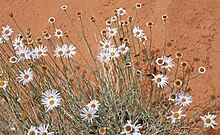en
names in breadcrumbs


The form of Erigeron divergens with persistent, deeply pinnatifid basal leaves with relatively long petioles and tendency toward perenniality (woody taproots) has been named E. accedens [occurs at 200–1000(–1200) m and flowers Feb–Apr(–May)]. Such plants have sometimes been identified as E. lobatus, and it is possible that they may have originated as hybrids with it; in most ways they are similar to E. divergens and apparently intergrade with it. The E. accedens form occurs in California, Arizona, New Mexico, southwest Texas, Baja California, northern Sonora, Durango, and Chihuahua, apparently sympatrically with more typical E. divergens, suggesting that the former is stabilized and self-reproductive (probably agamospermic). Available chromosome counts are triploid. Rare plants (e.g., E. incomptus) may have filiform rays barely extending past the involucre.
Another common form of Erigeron divergens in the broad sense (mostly in Chihuahua, also southern Texas, New Mexico, and Arizona) has bowl-shaped plants with decumbent stems, a discrete taproot, persistent, lobed basal leaves, and solitary heads topping usually simple stems, and usually is early-season in phenology. Further comments related to variation in E. divergens are found under 163. Erigeron multiceps.
Erigeron divergens is a species of flowering plant in the family Asteraceae known by the common name spreading fleabane. It is native to western North America.
This plant is highly variable in form. It is an annual or perennial herb growing from a taproot and sometimes a caudex. It produces one to many stems 7 to 70 centimeters (3 to 27+1⁄2 inches) tall. It is a hairy plant, and the hairs are usually glandular, at least near the top of the stem. The basal leaves are 1 to 7 cm (1⁄2 to 3 in) long, and leaves higher on the stem are smaller. Flowering from April to September, the inflorescence can hold over 100 flower heads, each about 2.5 cm (1 in) wide.[3] The heads have 75 to 150 ray florets not more than 1 cm long which are white in color, fading purple, and sometimes absent. There are many yellow disc florets at the center. The fruit is seed-like and about 1 millimeter (1⁄16 in) long with bristles on the tip.[4][3]
The species exhibits agamospermy, asexual reproduction via seeds. Many, but not all, individuals are polyploid.[4] There are many similar species both inside and outside the genus.[3]
This plant can be found in the western half of the United States (as far east as western Texas),[3] the Canadian provinces of British Columbia and Alberta, and the Mexican states of Baja California, Chihuahua, Durango, Nuevo León,[5] and Sonora.[6][7] It occurs in many types of habitat, including desert shrublands and scrubs, grassland, meadows, pinyon–juniper woodland, oak and pine woodlands, riparian habitat, sagebrush, and disturbed areas.[4]
This plant had a number of uses in Native American traditional medicine. The Navajo used it as an aid in childbirth, as a lotion, an eyewash, and a treatment for snakebite and headache. It was a good luck charm among the Kiowa people.[8]

Erigeron divergens is a species of flowering plant in the family Asteraceae known by the common name spreading fleabane. It is native to western North America.
This plant is highly variable in form. It is an annual or perennial herb growing from a taproot and sometimes a caudex. It produces one to many stems 7 to 70 centimeters (3 to 27+1⁄2 inches) tall. It is a hairy plant, and the hairs are usually glandular, at least near the top of the stem. The basal leaves are 1 to 7 cm (1⁄2 to 3 in) long, and leaves higher on the stem are smaller. Flowering from April to September, the inflorescence can hold over 100 flower heads, each about 2.5 cm (1 in) wide. The heads have 75 to 150 ray florets not more than 1 cm long which are white in color, fading purple, and sometimes absent. There are many yellow disc florets at the center. The fruit is seed-like and about 1 millimeter (1⁄16 in) long with bristles on the tip.
The species exhibits agamospermy, asexual reproduction via seeds. Many, but not all, individuals are polyploid. There are many similar species both inside and outside the genus.
This plant can be found in the western half of the United States (as far east as western Texas), the Canadian provinces of British Columbia and Alberta, and the Mexican states of Baja California, Chihuahua, Durango, Nuevo León, and Sonora. It occurs in many types of habitat, including desert shrublands and scrubs, grassland, meadows, pinyon–juniper woodland, oak and pine woodlands, riparian habitat, sagebrush, and disturbed areas.
This plant had a number of uses in Native American traditional medicine. The Navajo used it as an aid in childbirth, as a lotion, an eyewash, and a treatment for snakebite and headache. It was a good luck charm among the Kiowa people.
 Erigeron divergens, Arches National Park
Erigeron divergens, Arches National Park